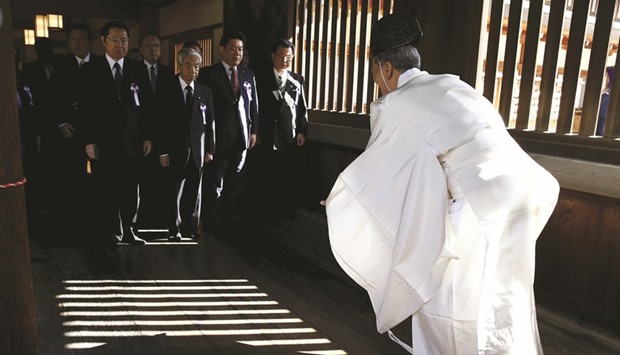Dozens of Japanese lawmakers including a Cabinet minister visited a Tokyo war shrine yesterday in a ritual angering China and South Korea, where memories of Japan’s military and colonial record remain raw.
The capital’s Yasukuni Shrine honours millions of Japanese dead, including several senior military and political figures convicted of war crimes after World War II.
The leafy central Tokyo shrine to Japan’s Shinto religion has for decades been a lightning rod for criticism by countries that suffered under Japan’s colonialism and aggression in the first half of the 20th century.
Visits to the shrine by senior Japanese politicians, including occasionally prime ministers, drew angry reactions from China and South Korea, which see it as a symbol of Tokyo’s militaristic past.
“We hope that political figures in Japan would develop a correct understanding of history and do more to promote reconciliation and mutual trust between Japan and its Asian neighbours,” Chinese foreign ministry spokeswoman Hua Chunying said at a regular briefing in Beijing.
South Korea also blasted the visit, with foreign ministry spokesman Cho June-Hyuck saying in a statement that the shrine “beautifies the colonial past and war of aggression, and enshrines war criminals”.
Prime Minister Shinzo Abe and other nationalists say that the shrine is merely a place to remember fallen soldiers and compare it to burial grounds such as Arlington National Cemetery in the United States.
At least 92 lawmakers visited Yasukuni for its annual spring festival, of whom 79 were from Abe’s ruling Liberal Democratic Party, according to an official working for upper house of parliament member Toshiei Mizuochi.
Internal Affairs Minister Sanae Takaichi visited the shrine, though separately from the other lawmakers, according to footage shown on public broadcaster NHK.
Takaichi’s visit was “private” in nature, Chief Cabinet Secretary Yoshihide Suga, the government’s top spokesman, told a news conference.
“A visit by a private person concerns the individual’s freedom of religion and the government should not intervene,” he added.
The figure this time compares with the more than 100 lawmakers and three ministers who visited during last year’s spring event.
For the shrine’s autumn festival six months ago 73 lawmakers and two ministers attended.
And on August 15, 2015 – the 70th anniversary of the end of World War II – two Cabinet ministers went to the shrine along with about 60 lawmakers.
Abe’s wife, Akie, also visited Yasukuni in December.
Yesterday’s visit by the lawmakers came a day after Abe made a ritual offering to the shrine.
Abe went in December 2013 to mark his first year in power, a pilgrimage that sparked fury in Beijing and Seoul and earned him a diplomatic rebuke from the United States, which said it was “disappointed” by the action.
He has since refrained from going and reactions by China and South Korea to Yasukuni visits, while remaining critical, have become less intense as Japan has taken steps over the past 18 months to improve relations with both countries and Abe has held summit meetings with their leaders.

A Shinto priest welcomes Japanese lawmakers during their visit to the Yasukuni shrine in Tokyo.


